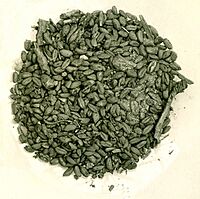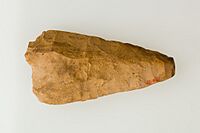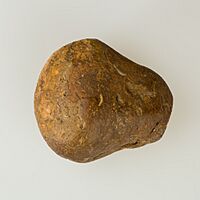Merimde culture facts for kids

Merimde clay head, Predynastic Period, Maadi Era, 4th millennium BCE. This is one of the earliest known representations of a human head in Egypt.
|
|
| Geographical range | Egypt |
|---|---|
| Period | Neolithic |
| Dates | c. 4,800 BC — 4,300 BC |
| Characteristics | Contemporary with Tasian culture, Badari culture |
| Preceded by | Faiyum A culture |
| Followed by | Amratian culture |
The Merimde culture was an ancient civilization that lived in the western Nile Delta in Lower Egypt. This culture existed during the Neolithic period, which was a time when people started farming and living in settled communities. Experts believe the Merimde culture thrived between 4800 and 4300 BC. The name "Merimde" also refers to the specific place where archaeologists found their remains. This culture existed around the same time as the Faiyum A culture and the Badari culture in other parts of Predynastic Egypt.
Contents
Discovering the Merimde Culture
The main area where the Merimde culture lived was a settlement called Merimde Beni Salama. This site is located in the western part of the Nile Delta, about 45 kilometers (28 miles) northwest of Cairo. A German archaeologist named Hermann Junker first found the site. He started digging there in 1928 and explored a large area of about 6,400 square meters.
At first, people thought the settlement covered about 25 hectares (62 acres). But newer studies show it was much bigger, at least 40 hectares (99 acres). Later, in the 1970s, more digging was done by the Egyptian Antiquities Organization and the German Institute of Archaeology. These new excavations helped scientists understand the different layers of the site, showing how the culture changed over time.
What Life Was Like in Merimde
The Merimde site shows that people lived there for nearly a thousand years. Archaeologists have found evidence of five different periods of development. In the earliest period, the people lived there only a little, and their tools and pottery were quite simple. As time went on, more people lived at the site, and they started building special areas for storing things.
Farming and Daily Life
The people of Merimde mainly relied on farming to get their food. They grew crops like grain. However, they also did some fishing and hunting to add to their diet. Their homes were small huts. These huts were built using a method called wattle and reed, which means they used woven branches and reeds. The huts usually had a round or oval shape. The pottery made by the Merimde people was simple and did not have wavy patterns.
How People Were Buried
The Merimde people had a unique way of burying their dead. It was different from the burial customs in Upper Egypt during the same time and later in ancient Egypt. They did not have separate areas for cemeteries. Instead, they buried people right within their settlement. The dead were placed in oval pits in a flexed position, which means their bodies were bent. They did not put any grave goods or offerings with the bodies.
Much later, during the time of the Maadi culture, the Merimde site was used as a cemetery. When archaeologists dug up the Merimde burials, they found many skeletons, mostly of females. These ancient people were generally taller and stronger than people from later periods in ancient Egypt. Their skulls were long and wide, similar to those found from the Tasian culture. Skulls from other cultures like the Badari culture and Amratian culture were usually smaller and narrower.
See also
- Population history of Egypt





